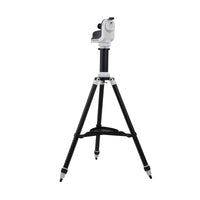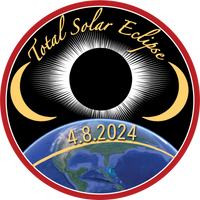
July 2018 Astronomy Calendar: Red Mars & Summer Nebulae
Mars At Its Best
This month we are introducing an observing challenge that will require a 6" or larger telescope, to celebrate the Mars opposition: Can you spot Mars' two small moons? See details at the end of the article.
July evenings begin with bright Venus in the west, followed by Jupiter, and Saturn in the East. These planets are the opening act before Mars steals the show. Mars begins the month rising a little before 11:PM from the SE. By the end of July, Mars will be rising just after sunset, and be out all evening. The best viewing for Mars will be the last two weeks of July and the first two weeks of August, with July 31 being the closest appraoch to Earth, with the Moon far enough away to allow good viewing.
The New Moon will be July 12th, granting the darkest skies. If you have the good fortune to be out away from the city, look for the Milky Way to slide across the night sky. Saturn is well positioned within the Milky Way this month, with the whole structure extending from North to South, rising as the Sun sets, with the very best viewing around midnight with the New Moon mid-month.
Four Summer Nebula
July is a great time to enjoy some of the bright nebula in the summer sky. These are objects best experienced under dark skies far from the city. Our object selection this month features targets that are good for any size telescope, but benefit best with a 6" and larger instrument.
From the Eagle to the Lagoon: Four bright nebulae sit nestled in the Milky Way in the southern sky. Saturn makes a good locator this month for this group of four targets. There are a lot of other great objects in this neighborhood, too, but these are four that stand out.

Start at the bottom with the Lagoon nebula, the largest and brightest of the four. A bright 4.59 magnitude star cluster nestled in the heart of the Lagoon makes it relatively easy to spot. The nebula itself lies about 5,200 lightyears distant, embedded in on of the galactic spiral arms of our Milky Way.
From there, move up to the Trifid nebula, which shows two distinct colors in photos, one being a reddish emission nebula, and one a blue reflection nebula. About 5,200 lightyears away, and with a total diameter similar to that of the full Moon, this is a favorite for amateur astronomers. The nearby M21 star cluster makes a nice pairing in a wide angle view or in binoculars.
In a small telescope, the Omega nebula is one of the best summer nebula. The red hydrogen emission nebula is about 5,500 lightyears distant and, like the winter favorite Orion nebula, is a stellar nursery with new stars either still forming, or star formations only recent having ceased. The nebula itself actually hides some 35 bright stars 20-30 times more massive than our sun, but masked from the visible spectrum by the gas and dust of the nebula.
The Eagle nebula is home to one of the most famous Hubble images: The Pillars of Creation. It is also a stellar nursery with a cluster of stars at its heart. Best viewed in larger telescopes, the gas and dust pillars can be perceived in about an 8" instrument, but are best seen photographically. In more modest telescopes, the nebula's namesake shape can be seen with the spread wings of an eagle soaring through our galaxy about 7,000 lightyears distant.
| Nebula Name | Designation | Magnitude | Size |
| Eagle Nebula | M16 | 6.4 | 35x28 arcmin |
| Omega Nebula | M17 | 6.0 | 46x37 arcmin |
| Trifid Nebula | M20 | 6.3 | 29x27 arcmin |
| Lagoon Nebula | M8, NGC 6523 | 6.0 | 90x40 arcmin |
Note on Size: an arc-minute is 1/60th of a degree. The Moon is approximately 32 arcminutes (about 0.5°) in diameter.
Note on Magnitude: The magnitude scale works in reverse, so that high numbers represent dimmer objects. From a dark site, magnitude 6 is the dimmest star that is naked-eye visible. Nebula and galaxies have that brightness spread out over a larger area vs a point source, requiring a telescope to see them. Saturn by way of comparison is magnitude 0.1 this month, and Jupiter is Mag -2.3: brighter than most stars.
 |
 |
| Eagle Nebula (at top) and Omega Nebula (at bottom). | Trifid Nebula (top) and Lagoon Nebula (bottom). |
| Photos © Sorin, all rights reserved. |
Calendar of Events
July 15: Moon and Venus
The waxing crescent Moon will appear just 2° from Venus. Since the Moon will only be 12% illuminated, the difference in brightness between the two will be relatively small (Venus at -3.9, the Moon at -6.3). This will make a nice pairing in binoculars.

July 20: Moon and Jupiter
The Moon and Jupiter will once again share the spotlight, just 3.5° apart, this will be a hard to miss pairing in the southern sky after sunset.
July 24: Moon and Saturn Conjunction
A few days after Jupiter, the Moon will pay an even closer visit with Saturn, just 1.5° apart. They will be in a very crowded patch of the Milky Way, but the bright Moon will wash out all of the surrounding nebula and clusters to steal the show.

July 27: Mars at Opposition
The star of the show, Mars reaches opposition on the 27th. With the Full Moon just 8.5° away, it will be difficult to make out much detail. The best viewing will actually be a few nights later, on July 31st.
July 31: Mars Closest To Earth
At just 35.8 million miles, this is the nearest Mars will get to Earth for the next 17 years. For us in the Northern hemisphere, Mars and the other planets stay very low to the south, with Mars only about 24° above the horizon at its peak. Even so, from last July through mid-august will be the very best chance to see the red planet for many years to come, so be sure to take advantage.
July Telescopic Challenge: Mars' Moons

Looking for a challenge this month? Mars has two small Moons, Phobos and Deimos. They are in a close orbit to Mars, and very dim compared to the Red Planet. Seeing them will require a 6" or larger telescope, and a bit of ingenuity to block out the bright disk of Mars itself. This involves creating your own occulting bar. See this article from Sky & Telescope to see how it's done.
The image above shows the alignment of Deimos, Phobos, and Mars as they will appear at 3:AM on July 31st. Refer to your own planetarium software to see the positions of the Moons throughout each evening. Phobos has a 7 hour and 39 minute orbital period, and Deimos has a 1 day, 6 hour, and 18 minute orbital period.
Manage to meet the challenge? Let us know in the comments!
Don't forget to join our newsletter for regular night sky updates!
All times unless otherwise indicated are Mountain Time. Sky charts were generated with Sky Safari Pro for an observer in Denver, Colorado.
Featured image: True color image of Mars taken by the OSIRIS instrument on the ESA Rosetta spacecraft during its February 2007 flyby of the planet. More Information.




